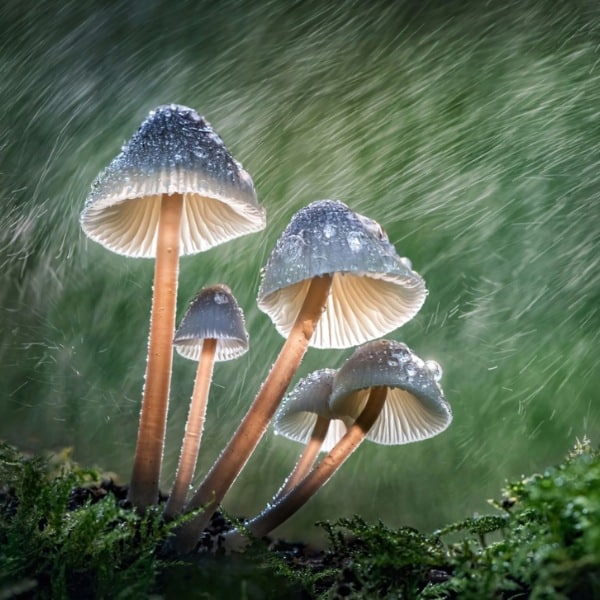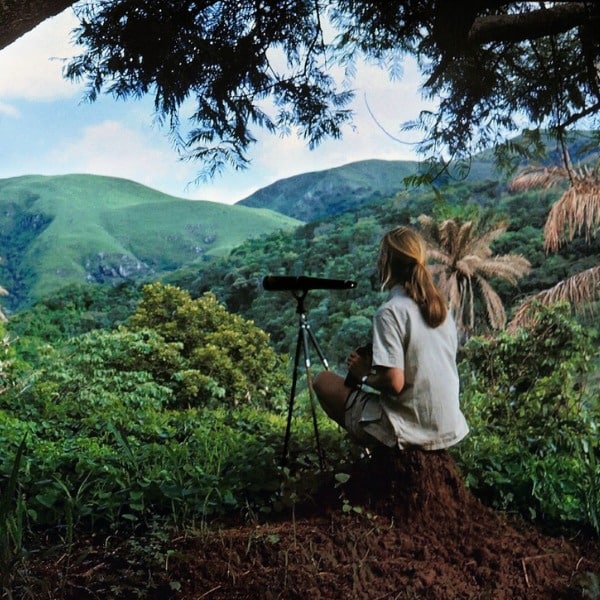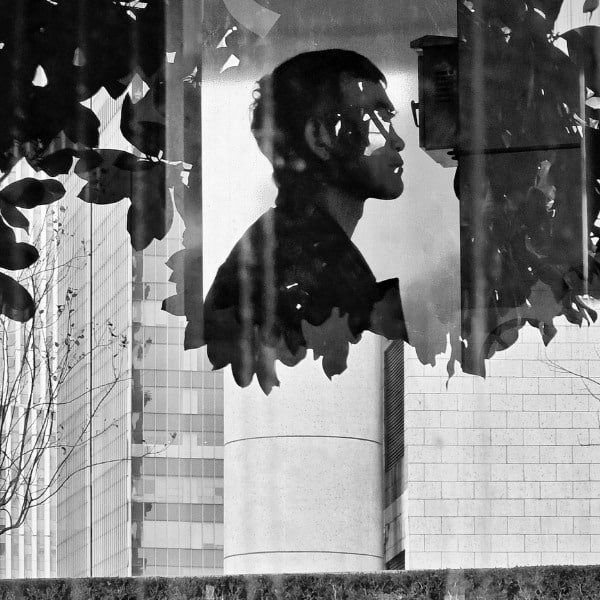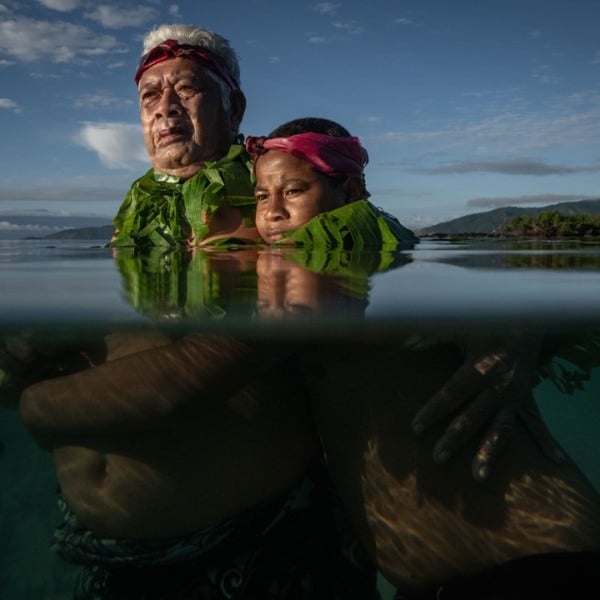
“Lynx on the threshold” by Sergio Marijuán, Spain. Highly commended, Urban Wildlife
A young Iberian lynx pauses in the doorway of the abandoned hayloft where it was raised, on a farm in eastern Sierra Morena, Spain. He will soon be leaving his mother’s territory. Once widespread on the Iberian Peninsula of Spain and Portugal, by 2002 there were fewer than 100 lynx in Spain and none in Portugal. Their decline was driven by hunting, killing by farmers, habitat loss and loss of prey (they eat mainly rabbits). Thanks to ongoing conservation efforts—reintroduction, rewilding, prey boosting and the creation of natural corridors and tunnels—Iberian lynx have escaped extinction and, though still endangered, are fully protected. Only recently, with numbers increasing, have they begun to take advantage of human environments. This individual is one of the latest in a family line to emerge from the old hayloft. After months of waiting, Sergio’s carefully-set camera trap finally gave him the picture he wanted.”
Now in its 57th year, the Wildlife Photographer of the Year is the Natural History Museum’s showcase for the world's best nature photography. Over 50,000 photos were entered into this year's contest by professional and amateur photographers around the world. While the winners won't be announced until October, the contest has released a selection of Highly Commended images for us all to enjoy.
With entries coming from 95 different countries, the shortlisted photographs represent a nice cross-section of the wildlife photography community. From an Iberian lynx calmly staring down the camera to an orphan flying fox being cradled by a caretaker, these photographs are a beautiful look at nature across the globe.
The diverse categories like Urban Wildlife, Behavior, and Animal Portraits allow the photographers to tell different stories about the wildlife that makes up our world. Some familiar names show up on the list, like renowned photographer Audun Rikardsen, while young photographers also have an impressive showing. Ten-year-old Gagana Mendis Wickramasinghe from Sri Lanka was highlighted for his extraordinary photo of a parakeet family taken from his balcony during lockdown.
The winners of the 2021 Wildlife Photographer of the Year awards will be announced in a virtual ceremony on October 12. Shortly after, next year's competition will open for entries until December. In the meantime, check out more of this year's Highly Commended imagery.
The Wildlife Photographer of the Year awards has announced a selection of Highly Commended images.
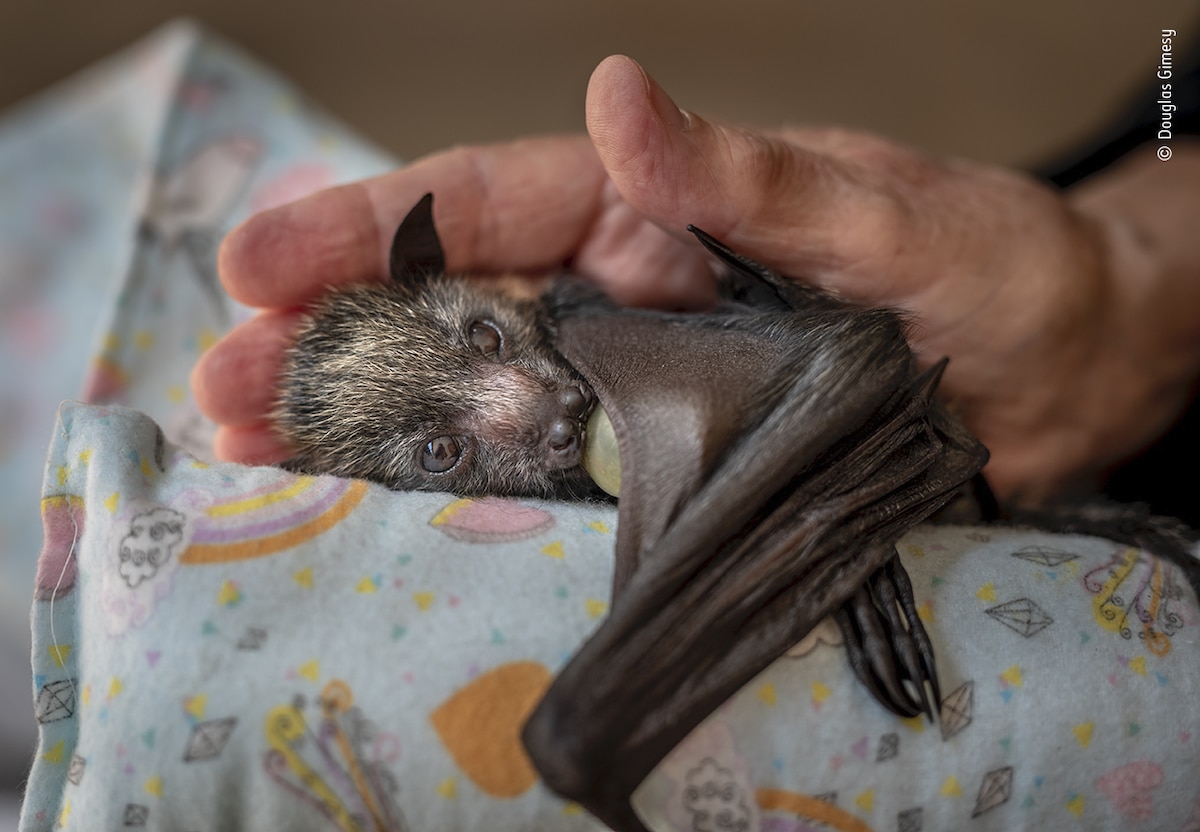
“A caring hand” by Douglas Gimesy, Australia. Highly commended, Photojournalism.
“After a feed of special formula milk, an orphaned grey-headed flying-fox pup lies on a ‘mumma roll’, sucking on a dummy and cradled in the hand of wildlife-carer Bev. She was three weeks old when she was found on the ground in Melbourne, Australia, and taken to a shelter. Grey‑headed flying-foxes, endemic to eastern Australia, are threatened by heat-stress events and destruction of their forest habitat—where they play a key role in seed dispersal and pollination. They also come into conflict with people, get caught in netting and on barbed wire and electrocuted on power lines. At eight weeks, the pup will be weaned onto fruit, then flowering eucalyptus. After a few months, she will join a crèche and build up flight fitness, before being moved next to Melbourne’s Yarra Bend bat colony, for eventual release into it.”
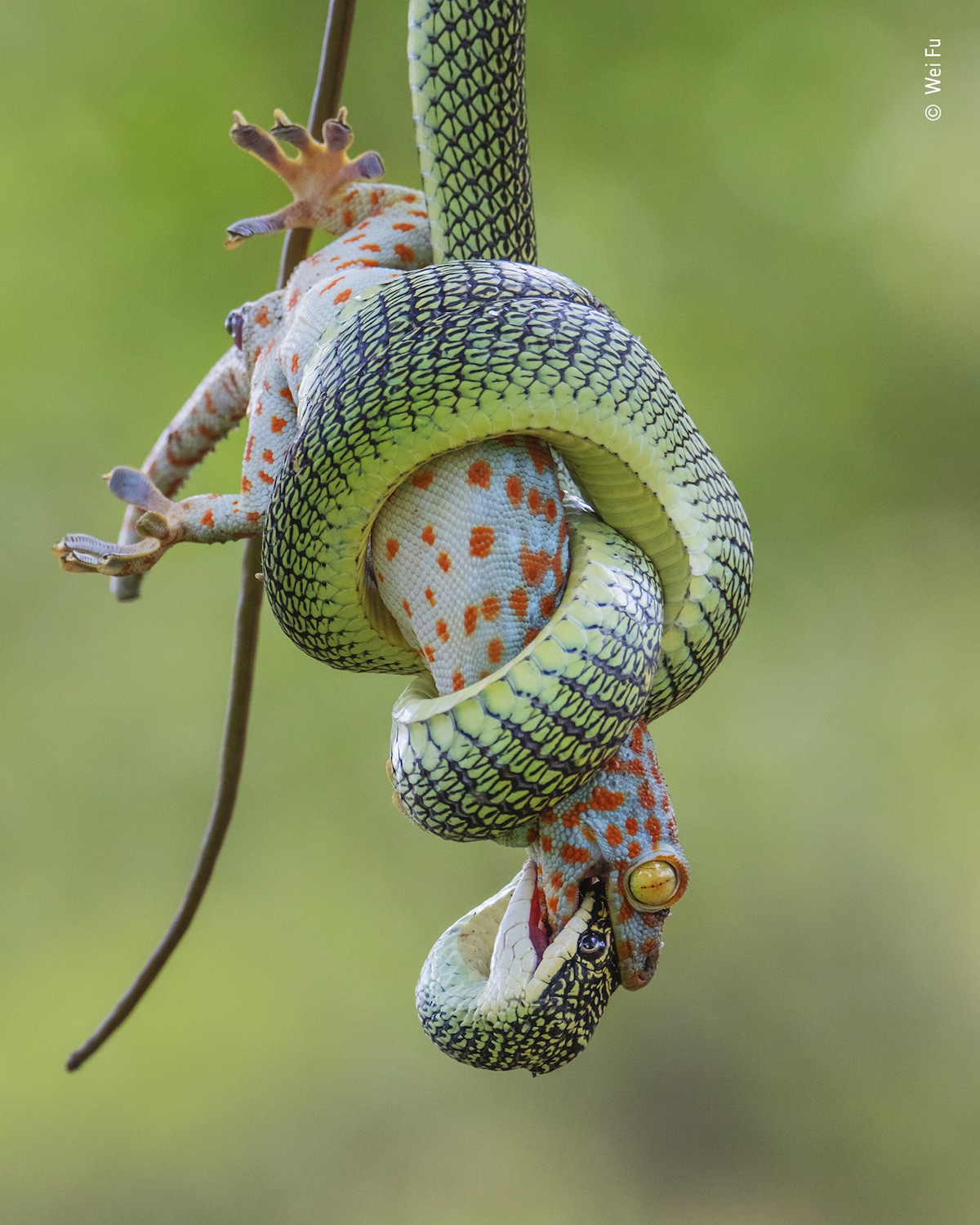
“The gripping end” by Wei Fu, Thailand. Highly commended, Behavior: Amphibians and Reptiles.
“Clutched in the coils of a golden tree snake, a red-spotted tokay gecko stays clamped onto its attacker’s head in a last attempt at defense. Named for their to‑kay call, tokay geckos are large—up to 40 centimeters (16 inches) long – feisty and have powerful jaws. But they are also a favorite prey of the golden tree snake. This snake, common in the lowland forests of South and Southeast Asia, also hunts lizards, amphibians, birds and even bats, and is one of five snakes that can ‘fly’, expanding its ribs and flattening its body to glide from branch to branch. Wei was photographing birds at a park near his home in Bangkok, Thailand, when his attention was caught by the loud croaking and hissing warnings of the gecko. It was being approached by the golden tree snake, coiled on a branch above and slowly letting itself down. As the snake struck, injecting its venom, the gecko turned and clamped onto the snake’s upper jaw. Wei watched as they wrestled, but within minutes, the snake had dislodged the gecko, coiled tightly around it and was squeezing it to death. While still hanging from the loop of its tail, the slender snake then began the laborious process of swallowing the gecko whole.”

“Storm fox” by Jonny Armstrong, USA. Highly commended, Animal Portraits.
“The fox was busy searching in the shallows for salmon carcasses—sockeye salmon that had died after spawning. At the water’s edge, Jonny was lying on his chest, aiming for a low, wide angle. The vixen was one of only two red foxes resident on the tiny island in Karluk Lake, on Alaska’s Kodiak Island, and she was surprisingly bold. Jonny had followed her over several days, watching her forage for berries, pounce after birds and playfully nip at the heels of a young brown bear. Taking advantage of the window of deepening atmospheric light created by a storm rolling in, he was after a dramatic portrait. But working with a manual flash, he had to pre set the power for a soft spotlight—just enough to bring out the texture of her coat at relatively close range. Now he was hoping she would come closer. As she did, his companion and fellow researcher raised up the diffused flash for him. It was just enough to pique her curiosity, giving Jonny his atmospheric portrait—studio-style—moments before the deluge of rain.”
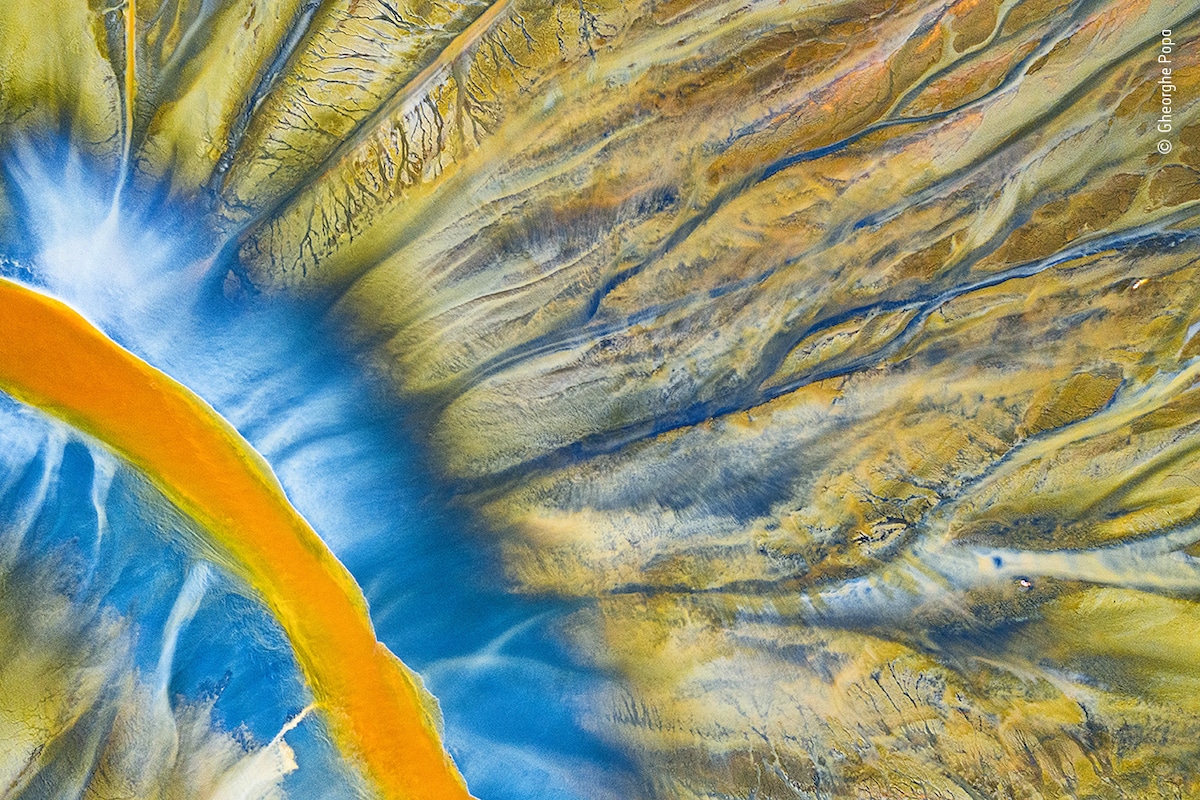
“Toxic design” by Gheorghe Popa, Romania. Highly commended, Natural Artistry.
“This eye-catching detail of a small river in the Geamana Valley, within Romania’s Apuseni Mountains, took Gheorghe by surprise. Though he had been visiting the region for several years, using his drone to capture images of the valley’s ever‑changing patterns, he had never come across such a striking combination of colors and shapes. But these designs—perhaps made sharp by recent heavy rain—are the result of an ugly truth. In the late 1970s, more than 400 families living in Geamana were forced to leave to make way for waste flowing from the nearby Rosia Poieni mine—a mine exploiting one of the largest deposits of copper ore and gold in Europe. The picturesque valley became a ‘tailings pond’ filled with an acidic cocktail, containing pyrite (fool’s gold), iron and other heavy metals, laced with cyanide. These toxic materials have infiltrated the groundwater and threatened waterways more widely. The settlement was gradually engulfed with millions of tons of toxic waste, leaving just the old church tower protruding and the sludge still piling up. His composition – ‘to draw attention to the ecological disaster’—captures the elemental colors of heavy metals in the river and the ornate radiating banks of this shockingly toxic landscape.”
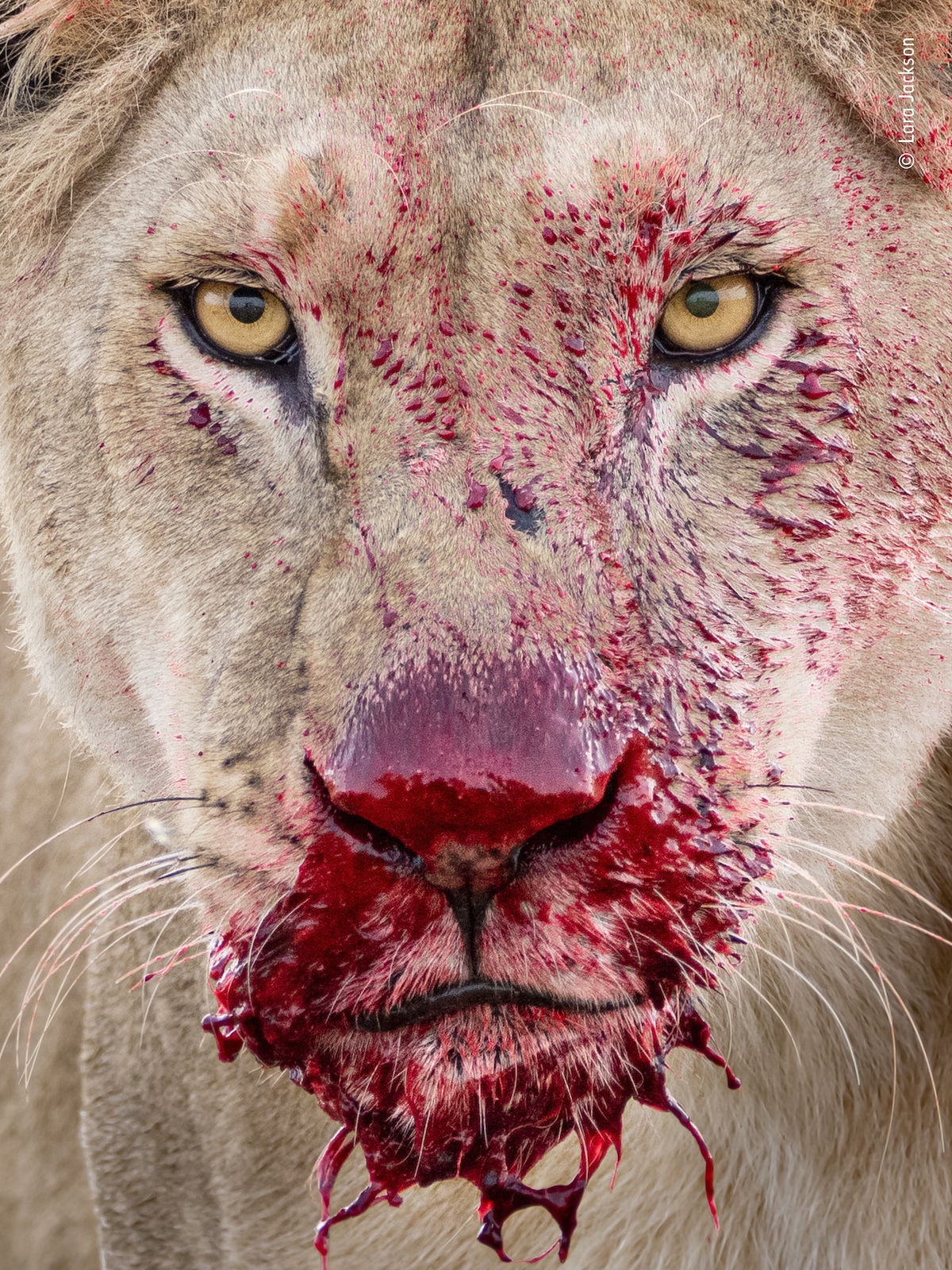
“Raw moment” by Lara Jackson, UK. Highly commended, Animal Portraits.
“Bright red blood dripped from her muzzle – oxygenated blood, indicating that her wildebeest meal was still alive. Perhaps being inexperienced, this young lioness had not made a clean kill and had begun eating the still struggling animal. Now, with a paw holding it down, she gave Lara an intense stare. More than two million wildebeest move through the north of Tanzania’s Serengeti National Park on their annual migration in search of greener grass, providing the Serengeti lions with a seasonal glut of food. Lara had spotted the lioness just as she pounced. Lions’ primary hunting strategy is stalking, but this one had just been resting in the long grass, when the wildebeest wandered by. ‘She was already quite full,’ says Lara, ‘probably after feeding the night before, but she grabbed the opportunity for an easy meal.’ Though most successful when hunting with a pride, a single lion can bring down an animal twice its weight. A lion would usually pull it down backwards or sideways and then lunge for the throat or nose, gripping firmly until the victim could no longer cause injury with flailing horns or hooves. Lying in a specially adapted vehicle, with the sides folded down, Lara framed her low-angle close-up. Her arresting portrait captures the rawness of the moment and the intensity of the lioness’s stare. She didn’t eat much, says Lara, before leaving the kill to walk off with the male whom she had been lying up with, seemingly more interested in mating than feeding.”
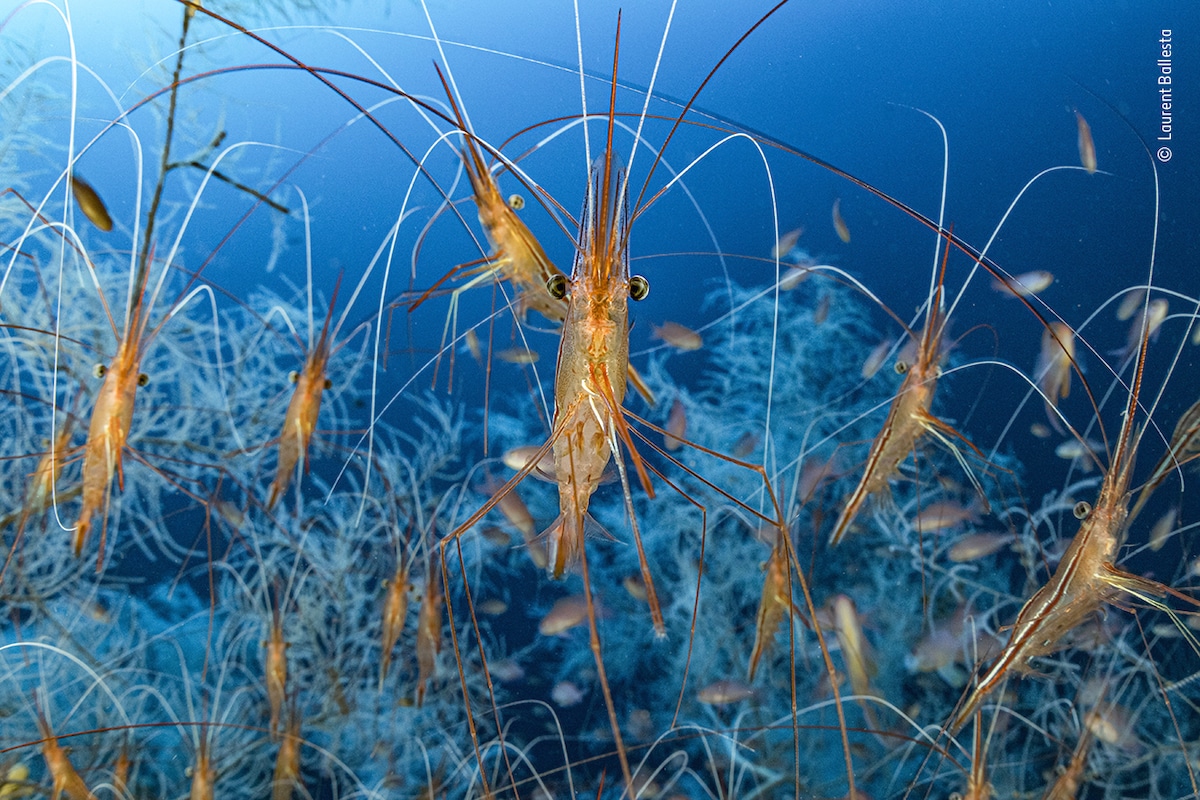
“Deep feelers” by Laurent Ballesta, France. Highly commended, Underwater.
“In deep water off the French Mediterranean coast, among cold-water black coral, Laurent came across a surreal sight—a vibrant community of thousands of narwhal shrimps. Their legs weren’t touching, but their exceptionally long, highly mobile outer antennae were. It appeared that each shrimp was in touch with its neighbors and that, potentially, signals were being sent across a far‑reaching network. Research suggests that such contact is central to the shrimps’ social behavior, in pairing and competition. In such deep water (78 meters down – 256 feet), Laurent’s air supply included helium (to cut back on nitrogen absorbed), which enabled him to stay at depth longer, stalk the shrimps and compose an image at close quarters. Against the deep-blue of the open water, floating among the feathery black coral (white when living), the translucent narwhal shrimps looked exceptionally beautiful, with their red and white stripes, long orange legs and sweeping antennae. Between a shrimp’s bulbous stalked eyes, flanked by two pairs of antennae, is a beak-like serrated rostrum that extended well beyond its 10-centimeter (4‑inch) bodies. Narwhal shrimps are normally nocturnal and often burrow in mud or sand or hide among rocks or in caves in the day, which is where Laurent was more used to seeing them. They are also fished commercially. When shrimp-fishing involves bottom‑trawling over such deep-water locations, it destroys the slow‑growing coral forests as well as their communities.”
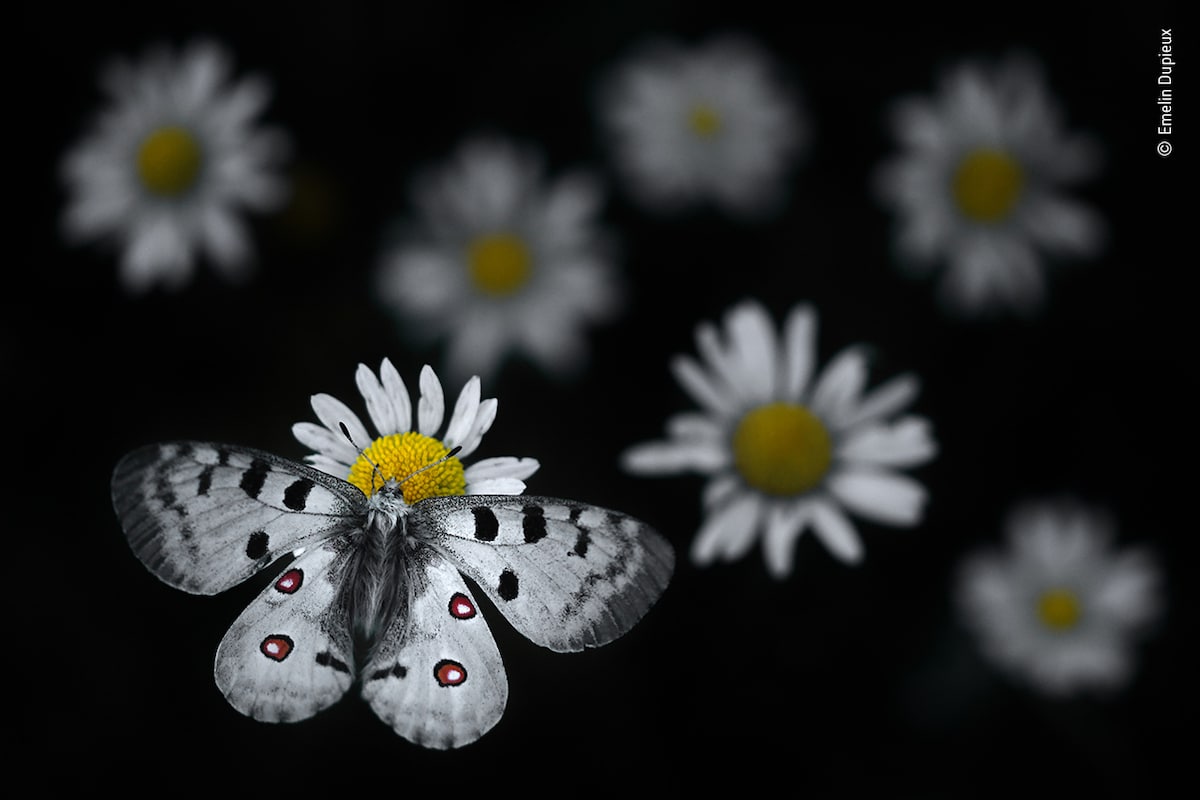
“Apollo landing” by Emelin Dupieux, France. Highly commended, 11-14 Years.
“As dusk starts to fall, an Apollo butterfly settles on an oxeye daisy. Emelin had long dreamed of photographing the Apollo, a large mountain butterfly with a wingspan up to 90 millimeters (31/2 inches) and now one of Europe’s threatened butterflies, at risk from the warming climate and extreme weather events. In summer, on holiday in the Haut-Jura Regional Nature Park, on the French‑Swiss border, Emelin found himself surrounded by alpine meadows full of butterflies, including Apollos. Though slow flyers, the Apollos were constantly on the move. The solution was this roost, in a woodland clearing, where the butterflies were settling. But a breeze meant the daisies were moving. Also the light was fading. After numerous adjustments of settings and focus, Emelin finally achieved his emblematic image, the whites standing out in stark contrast, and just daubs of color—the yellow hearts of the daisies and the red eyespots of the Apollo.”
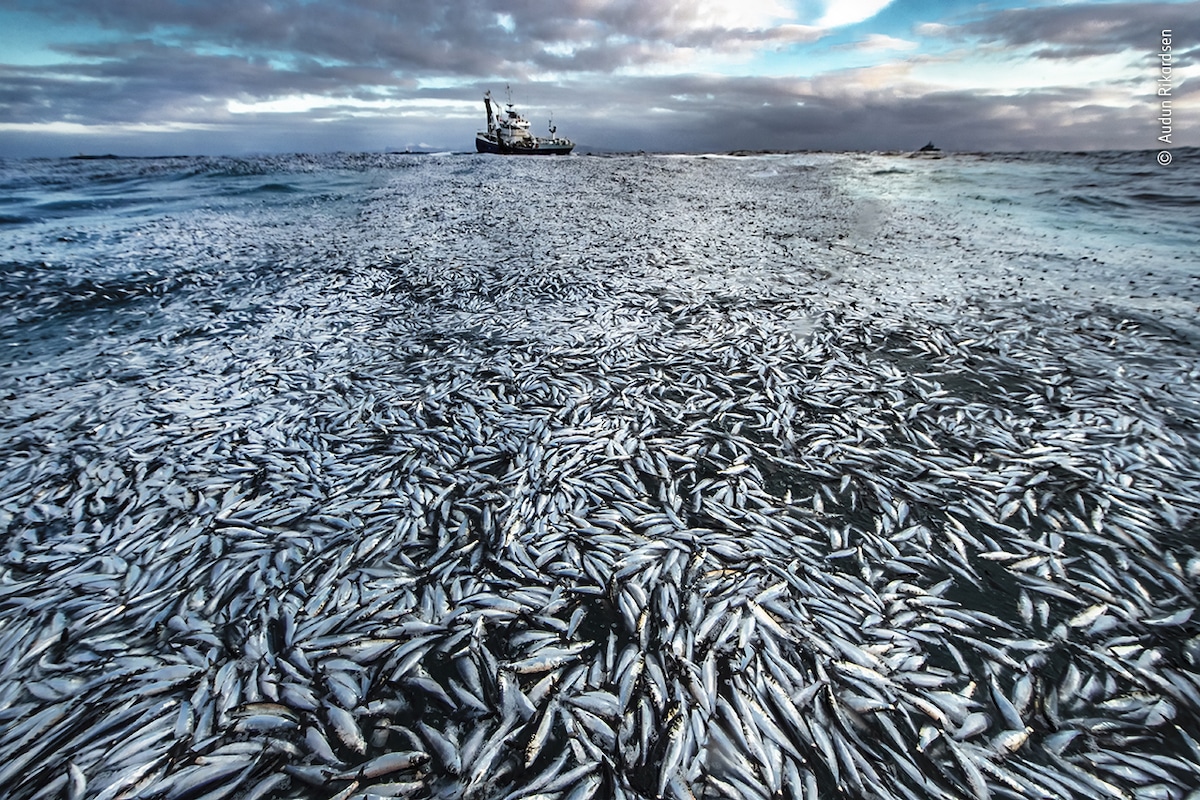
“Net loss” by Audun Rikardsen, Norway. Highly commended, Oceans – The Bigger Picture.
“In the wake of a fishing boat, a slick of dead and dying herrings covers the surface of the sea off the coast of Norway. The boat had caught too many fish, and when the encircling wall of the purse-seine net was closed and winched up, it broke, releasing tons of crushed and suffocated animals. Audun was on board a Norwegian coastguard vessel, on a project to satellite‑tag killer whales. The whales follow the migrating herrings and are frequently found alongside fishing boats, where they feed on fish that leak out of the nets. For the Norwegian coastguard—responsible for surveillance of the fishing fleet—the spectacle of carnage and waste was effectively a crime scene. So Audun’s photographs became the visual evidence in a court case that resulted in a conviction and fine for the owner of the boat. Overfishing is one of the biggest threats to ocean ecosystems, and according to the UN Food and Agriculture Organization, more than 60 per cent of fisheries today are either ‘fully fished’ or collapsed, and almost 30 per cent are at their limit (‘overfished’). Norwegian spring-spawning herring – part of the Atlantic herring population complex – was in the nineteenth century the most commercially fished fish population in the North Atlantic, but by the end of the 1960s, it had been fished almost to extinction. This is regarded as a classic example of how a combination of bad management, little knowledge and greed can have a devastating and sometimes permanent effect, not only on the species itself but on the whole ecosystem. The Atlantic herring came close to extinction, and it took 20 years and a near‑ban on fishing for the populations to recover, though it is still considered vulnerable to overfishing. The recovery of the herring has been followed by an increase in the numbers of their predators, such as killer whales, but it is a recovery that needs continued monitoring of herring numbers and fisheries, as Audun’s picture shows.”
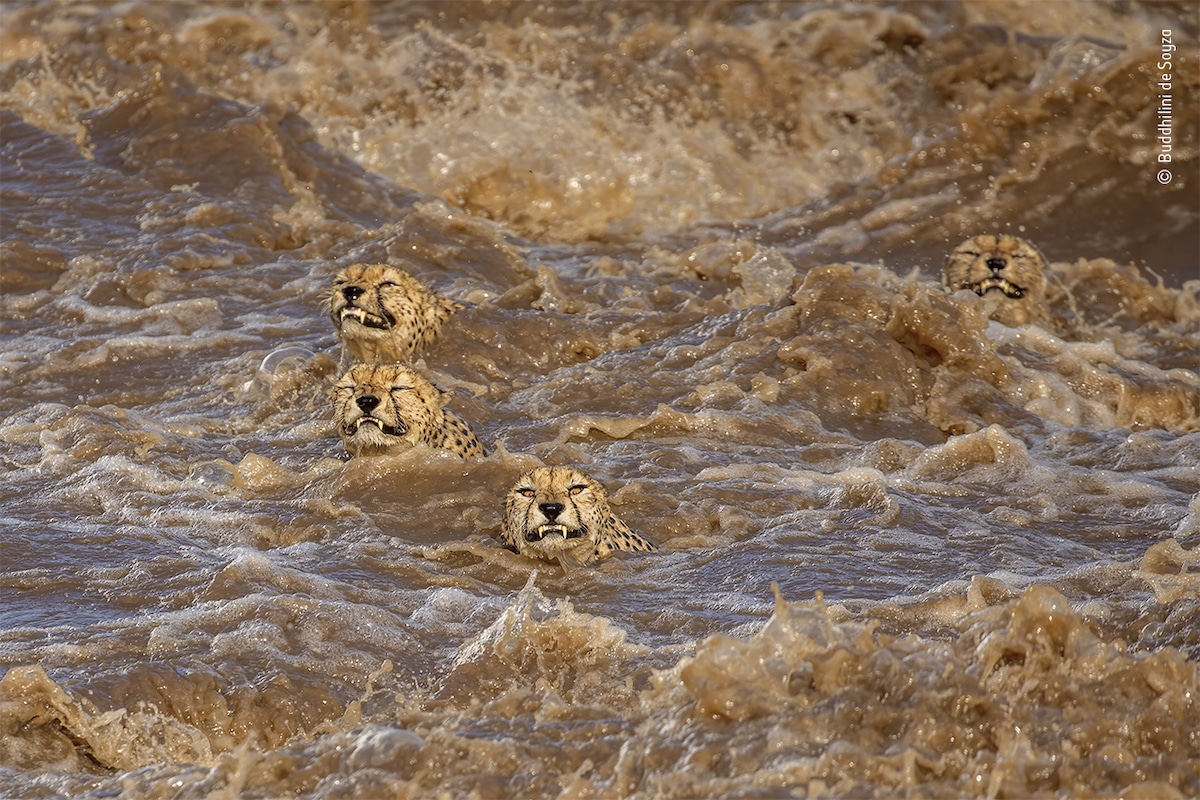
“The great swim” by Buddhilini de Soyza, Sri Lanka/Australia. Highly commended, Behavior: Mammals.
“When the Tano Bora coalition of male cheetahs leapt into the raging Talek River in Kenya’s Maasai Mara, Dilini feared they would not make it. Unseasonable, relentless rain (possibly linked to the changing climate) had, by January 2020, caused the worst flooding local elders had ever known. Cheetahs are strong (if not keen) swimmers, and with the prospect of more prey on the other side of the river, they were determined. Dilini followed them for hours from the opposite bank as they searched for a crossing point. Male cheetahs are mostly solitary, but sometimes they stay with their brothers or team up with unrelated males. The Tano Bora (Maasai for ‘magnificent five’) is an unusually large coalition, thought to comprise two pairs of brothers, joined later by a single male. ‘A couple of times the lead cheetah waded into the river, only to turn back,’ says Dilini. Calmer stretches—perhaps with a greater risk of lurking crocodiles—were spurned. ‘Suddenly, the leader jumped in,’ she says. Three followed, and then finally the fifth. Dilini watched them being swept away by the torrents, faces grimacing. Against her expectations and much to her relief, all five made it. They emerged onto the bank some 100 meters (330 feet) downstream and headed straight off to hunt.”
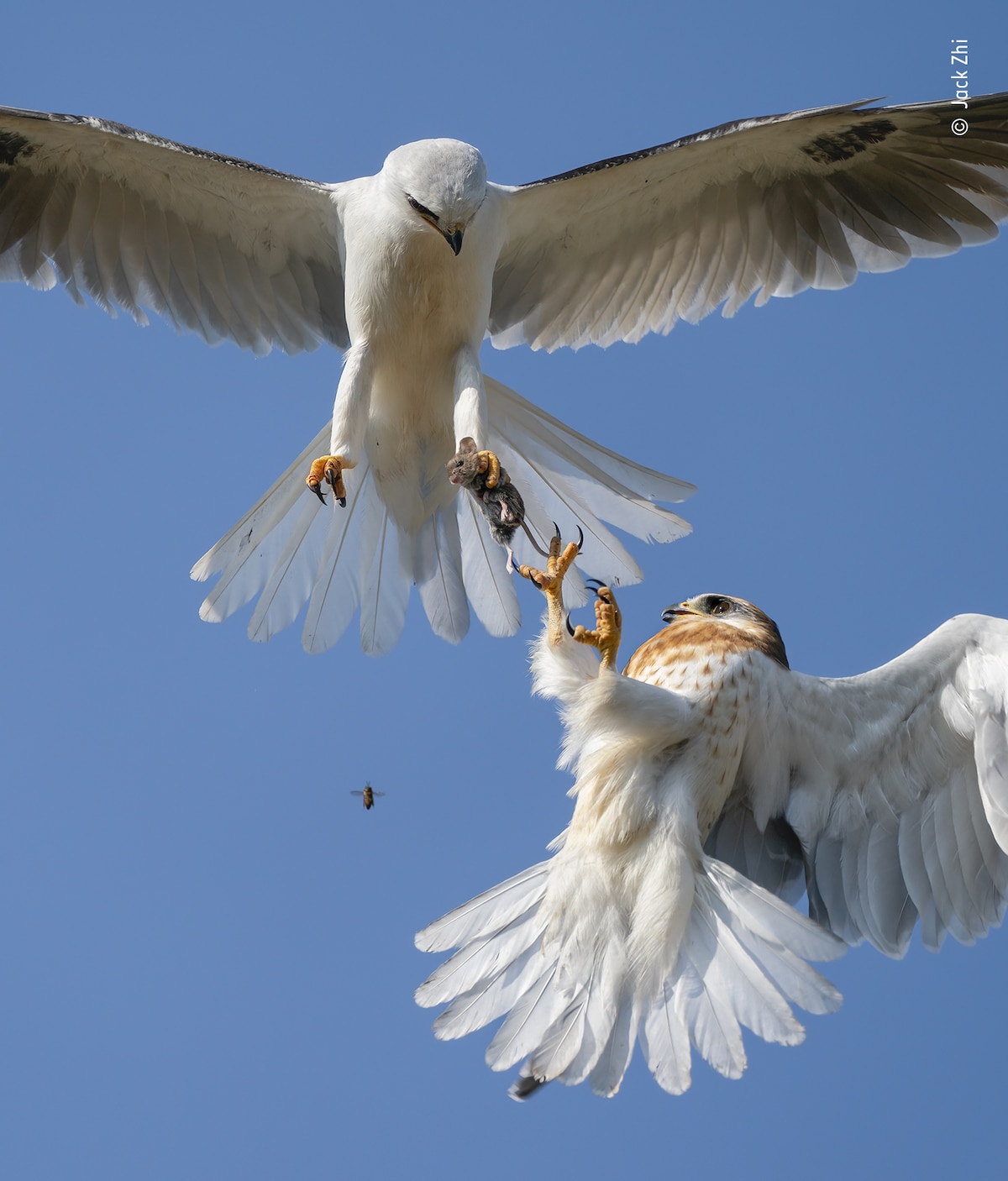
“Up for grabs” by Jack Zhi, USA. Highly commended, Behavior: Birds.
“In southern California, USA, a juvenile white-tailed kite reaches to grab a live mouse from the clutches of its hovering father. A more experienced bird would have approached from behind (it’s easier to coordinate a mid-air transfer if you are both moving in the same direction), but this cinnamon streaked youngster had been flying for just two days and still had much to learn. It must master aerial food exchange until it is capable of hunting for itself (typically by hovering, then dropping down to grab mainly small mammals). Later, it needs to perform aerial courtship rituals (where a male offers prey to a female). To get the shot, Jack had to abandon his tripod, grab his camera and run. The result was the highlight of three years’ work—the action and the conditions came together perfectly. Meanwhile, the fledgling missed but then circled around and seized the mouse.”
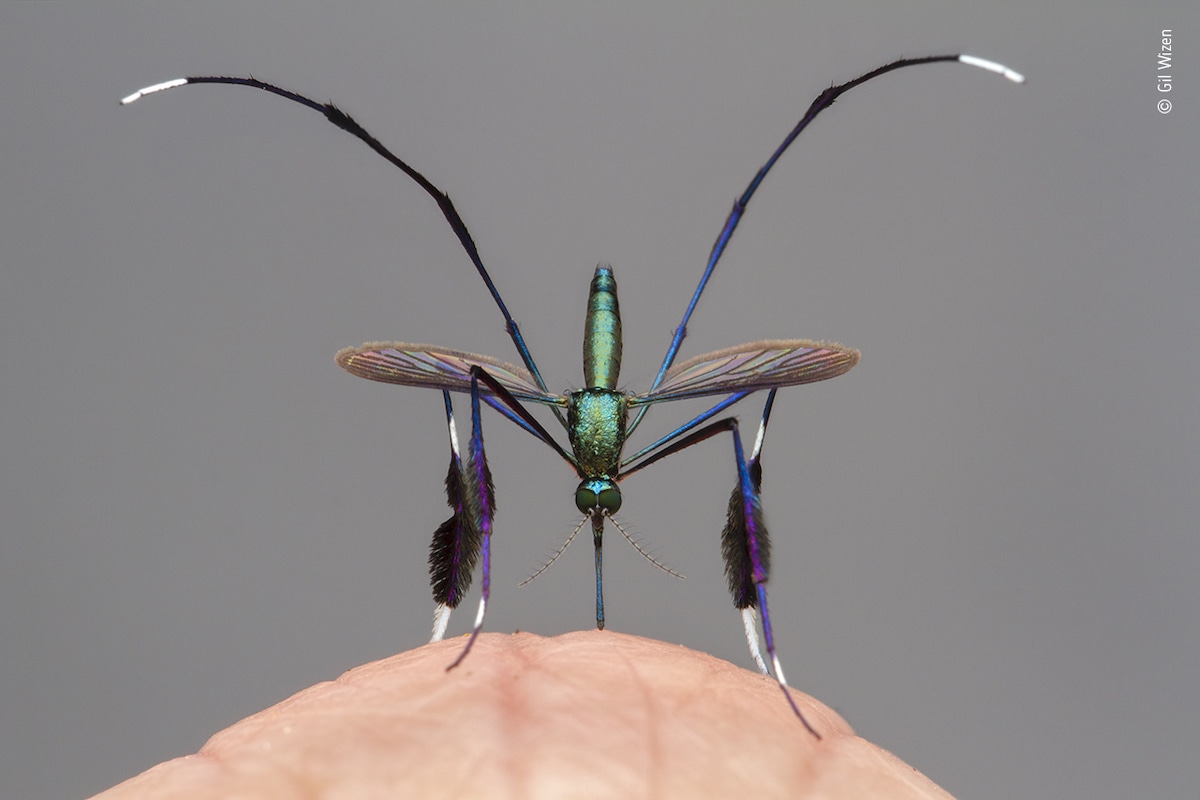
“Beautiful bloodsucker” by Gil Wizen, Israel/Canada. Highly commended, Behavior: Invertebrates.
“The best way to photograph a female ornamented mosquito, says Gil, is to let it bite you. The elegant Sabethes mosquitoes, found only in Latin America, are just 4 millimeters (0.16 inches) long and skittish. Only the females bite—they need a blood meal to produce eggs—and in doing so, can act as vectors of tropical diseases such as yellow fever and dengue fever. Their long legs sport brushes of hairs (possibly important in attracting mates), and their hind legs are typically raised and waved around as they bite. With large compound eyes and sensitive, feathery antennae, they can detect the slightest movement. So when this one, in central Ecuador, landed on Gil, he kept stock-still as he framed it, head on, proboscis poised to pierce his finger knuckle. Focus-stacking six exposures, he captured it in perfect symmetry, highlighting its jewel-like body and iridescent wings against the neutral background of his hiking trousers. Its bite, he admits, was rather painful.”
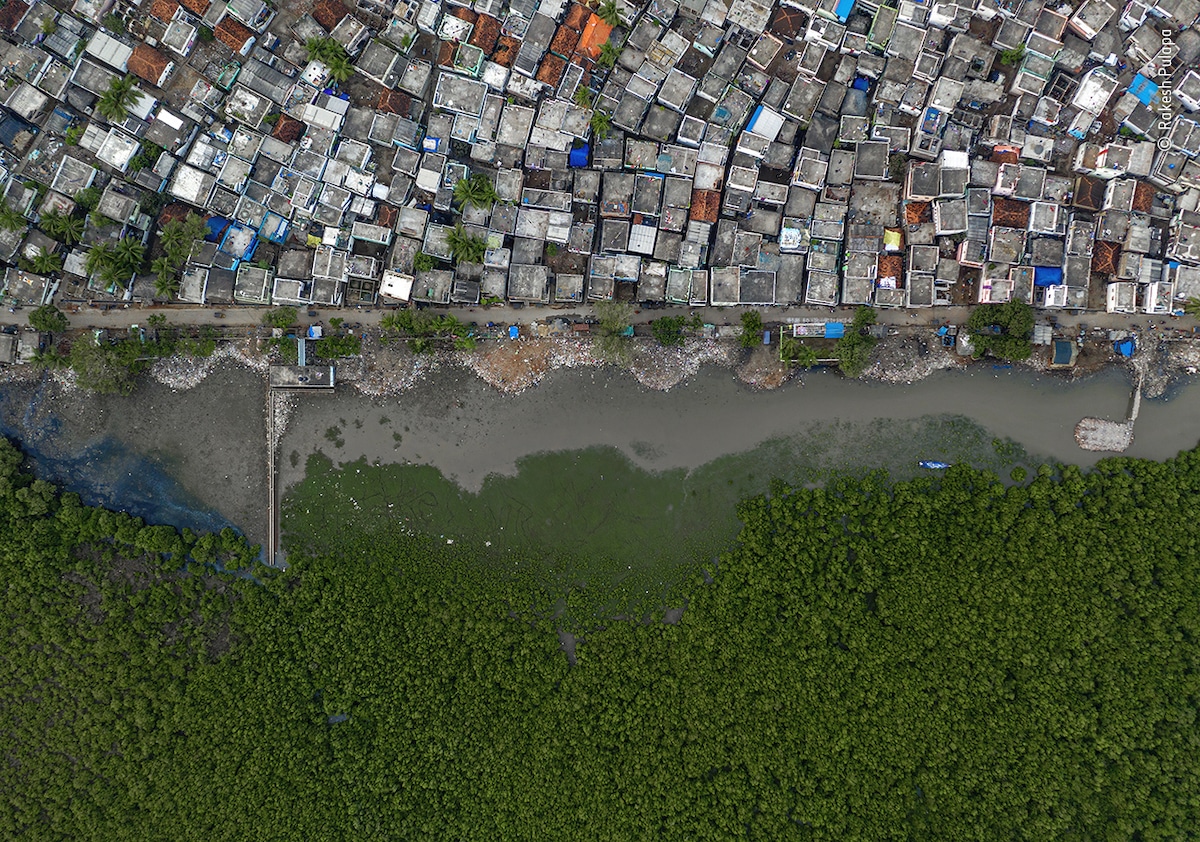
“The nurturing wetland” by Rakesh Pulapa, India. Highly commended, Wetlands – The Bigger Picture.
“Houses on the edge of Kakinada city reach the estuary, buffered from the sea by the remains of a mangrove swamp. Development has already destroyed 90 per cent of mangroves—salt-tolerant trees and shrubs—along this eastern coastal area of Andhra Pradesh, India. But mangroves are now recognized as vital for coastal life, human and non-human. Their roots trap organic matter, providing carbon storage, slow incoming tides, protect communities against storms and create nurseries for numerous fish and other species that fishing communities rely on. Flying his drone over the area, Rakesh could see the impact of human activities—pollution, plastic waste and mangrove clearance—but this picture seemed to sum up the protective, nurturing girdle that mangroves provide for such storm-prone tropical communities.”
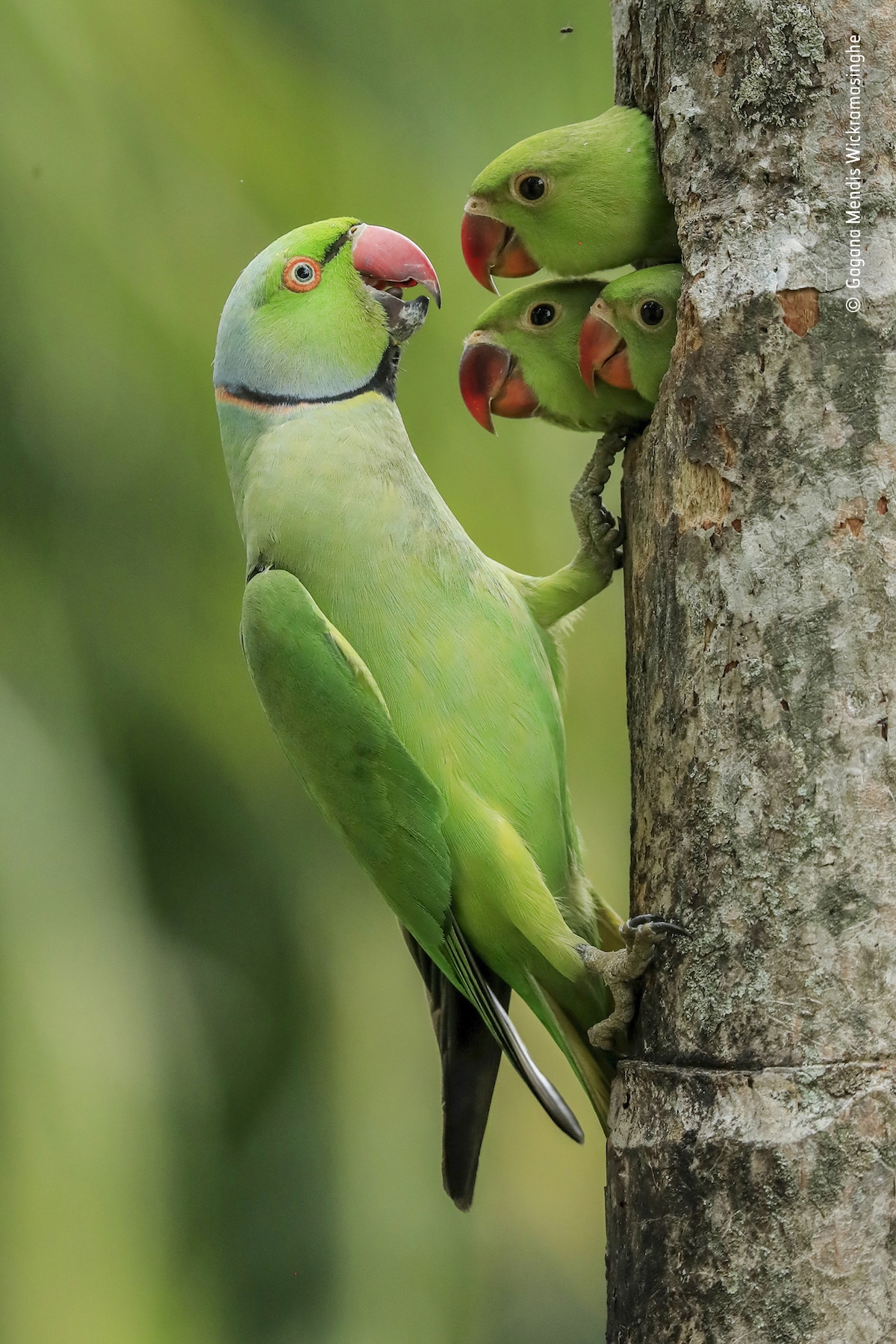
“Lockdown chicks” by Gagana Mendis Wickramasinghe, Sri Lanka. Highly commended, 10 years and under
Three rose-ringed parakeet chicks pop their heads out of the nest hole as their father returns with food. Watching was 10‑year-old Gagana, on the balcony of his parents’ bedroom, in Colombo, Sri Lanka. The hole was at eye level with the balcony, in a dead areca-nut palm in the backyard, which his parents had deliberately left standing to attract wildlife. In the spring of 2020, during the long days of the island-wide lockdown, Gagana and his older brother had hours of entertainment watching the parakeet family and experimenting with their cameras, sharing lenses and a tripod, always mindful that the slightest movement or noise would stop the chicks showing themselves. When incubating the eggs, the female stayed inside while the male foraged (for fruit, berries, nuts and seeds mainly), feeding her by regurgitating food. When Gagana took this picture, both parents were feeding the growing chicks. Only when they fledged did Gagana realize that there were as many as five chicks. Also known as ring‑necked parakeets, these medium-sized parrots are native to Sri Lanka, India and Pakistan as well as a band of sub‑Saharan Africa, but feral populations are now found in many countries including the UK. These are often found in urban settings, where they sometimes even breed in holes in brick walls.”
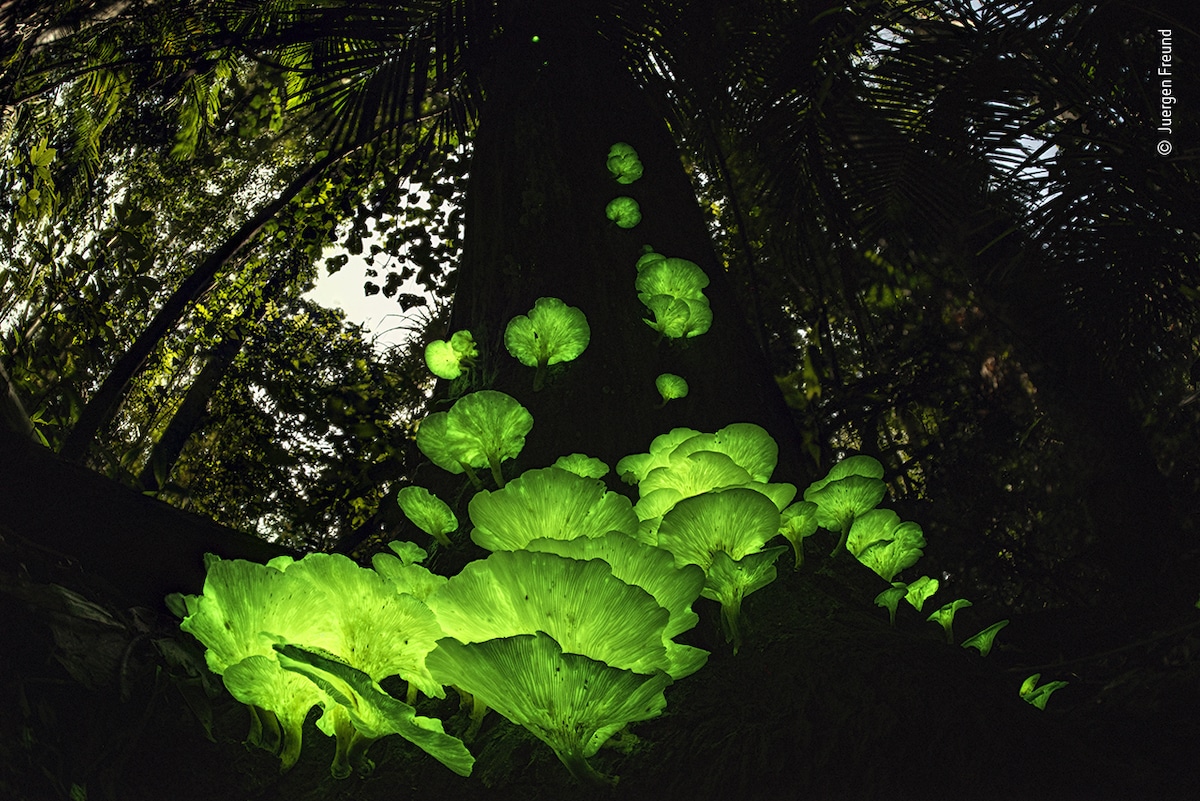
“Mushroom magic” by Juergen Freund, Germany/Australia. Highly commended, Plants and Fungi.
“It was on a summer night, at full moon, after monsoon rain, that Juergen found the ghost fungus, on a dead tree in the rainforest near his home in Queensland, Australia. He needed a torch to keep to the track, but every few meters he would switch it off to scan the dark for the ghostly glow. His reward was this cluster of hand-sized fruiting bodies. Comparatively few species of fungi are known to make light in this way, through a chemical reaction: luciferin oxidizing in contact with the enzyme luciferase. But why the ghost fungus glows is a mystery. No spore‑dispersing insects seem to be attracted by the light, which is produced constantly and may just be a by-product of the fungi’s metabolism. Juergen crouched on the forest floor for at least 90 minutes to take eight five minute exposures – to capture the dim glow – at different focal points, which were merged (focus stacked), to create one sharp-focus image of the tree-trunk display.”
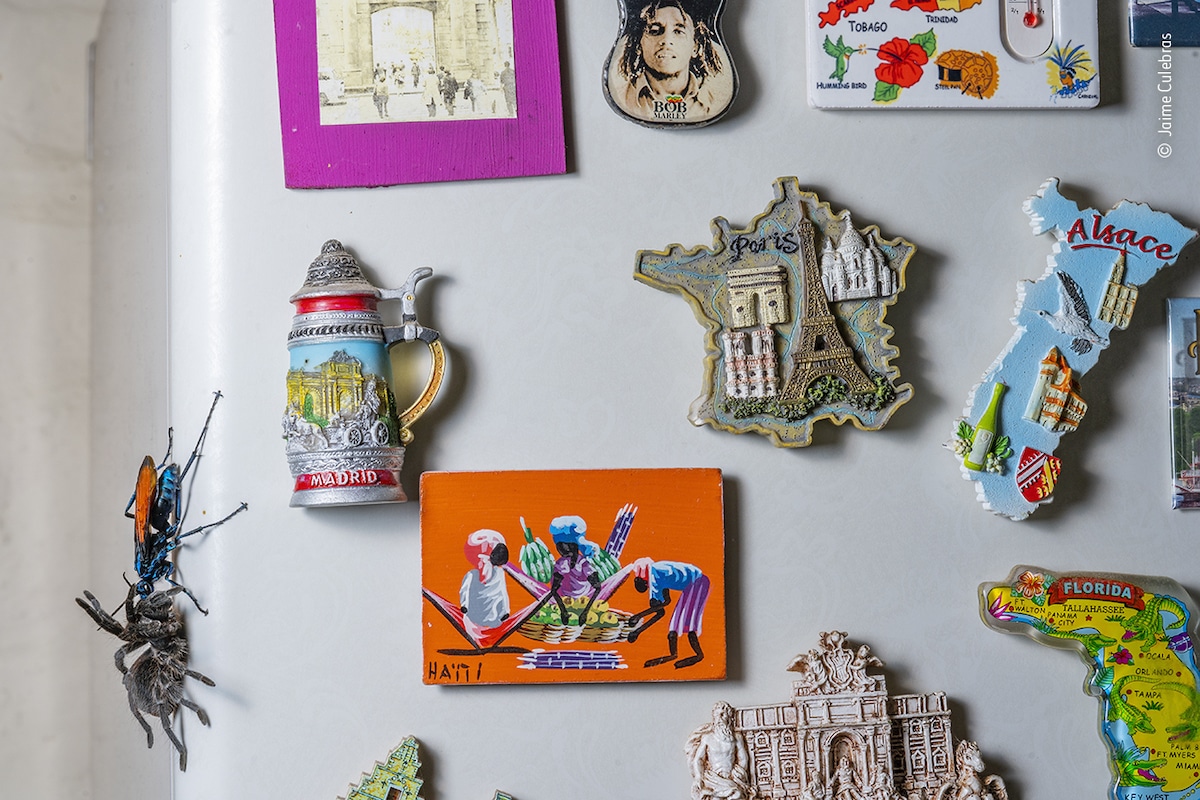
“Natural magnetism” by Jaime Culebras, Spain. Highly commended, Urban Wildlife.
“When Jaime spotted this tarantula hawk wasp dragging a tarantula across his kitchen floor, in Quito, Ecuador, he rushed to get his camera. By the time he got back, the giant wasp—nearly 4 centimeters (11/2 inches) long—was hoisting its victim up the side of the fridge. Tarantula hawks are said to have among the most painful stings on the planet, deadly when used on a spider. They actually feed on nectar and pollen, but the females also hunt tarantulas as food for their carnivorous larvae. The wasp injects her victim with venom via a sharp, curved sting, then drags it—paralyzed but still alive—to her nest, where she lays a single egg on its body. When the egg hatches, the larva burrows into the spider’s body and eats it alive, eventually emerging as an adult. Jaime waited for the colorful wasp to level with his fridge magnets, then framed his shot to include this passing addition to his collection.”











































































